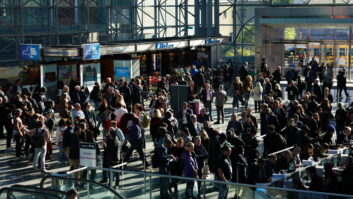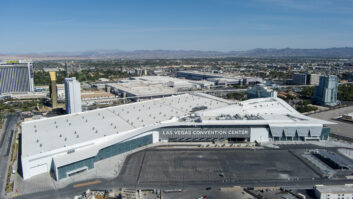
Early Fremont Street
Las Vegas is a fascinating town. First a wagon train layover, later a railroad junction, it has morphed into a Mecca for conventioneers, pleasure-seekers and risk-takers from around the world.
Given its colorful past (not to mention the present), it is not surprising that the town has a unique character. So as we once again pack our bags for the annual pilgrimage to The Show, consider some tidbits about our host city with which you can amaze and amuse your seatmates on the flight out.
Bugsy and the Rose Garden
In the 1940s an L.A. bad guy named Benjamin Siegel was sent here by the mob to build a desert getaway for wiseguys and other West Coast types.
He built the Flamingo Hotel with money collected from various shady enterprises, and semi-retired to the desert. Vegas in those days was not the glitz machine it is today; there were no pirate ships, no spewing volcanoes, no gondola rides. In fact, his was only the second “real” hotel on the Strip, (the first being the El Rancho).
The Strip itself was not even part of Las Vegas back then. The actual town was centered around Fremont and Main Streets, the current bubble-topped “Casino Center.” The population was only around 20,000 in 1947.
Bugsy, as he was called, had plenty of time to take up a hobby. He chose gardening. That pastime had a distinct advantage for a guy with Bugsy’s background, who could always use a few extra holes in the ground into which he might occasionally throw things other than flowers. Legend has it that some of those plantings were nocturnal.
The rose garden was still beautiful when I saw it for the first time in 1969. Even though it is gone now, it lasted much longer than did the gardener.
After a conflict with a partner in 1947, Bugsy went back to L.A. for a showdown, whereupon, not unlike his prized roses, he was himself pruned, apparently by one of the guys he should have planted back at the Flamingo.
An early contradiction of the idea that what happens in Vegas, stays in Vegas.
24/7
Las Vegas is the original 24 hour city. The strip doesn’t shut down. Nuclear holocaust? That’ll have to wait, I’ve doubled down here.
The culinary workers went on strike in 1984 and thought they would force the casinos to close — who wants to mess with several thousand guys carrying knives? — but even then the lights stayed on and the cards were dealt. (The buffet lines, however, suffered greatly; no doubt several thousand head of beef owed their lives to that strike, as the hotels were forced to substitute lasagna and brussel sprouts for prime rib.)

Las Vegas history can be divided roughly into chapters that include wagon trains, Rat Pack, family entertainment and Sin City. Since the first NAB convention in Vegas in 1974, the lights on the strip have been doused only once that I know of: when Ol’ Blue Eyes died in 1998. Even then the darkness was fleeting; about 15 minutes is my recollection, because after all, blackjack waits for no man.
At least until recently. The city decided it should extinguish the lights on the Strip — even the famous “Welcome to Fabulous Las Vegas” sign at the extreme south end of Las Vegas Boulevard — for 60 minutes in honor of Earth Hour 2009, an event to place focus on climate change.
So, what the Strike of a Thousand Knives could not do, Al Gore accomplished. I am amazed; I would’ve given 2-to-1 on the workers.
The Curse of Mt. Potosi
There is a mountain about 25 miles southwest of town that is home to a couple of FM transmitters and used to be a microwave site for two of the Las Vegas TV stations. It is called Mt. Potosi, (which the locals pronounce POE-tuh-see).
I’m told that Potosi means “lead” in Spanish and that the mountain got that name because of the discovery of the metal there, but do not be fooled; I believe it is really an obscure Indian word that roughly translates to “The Mountain of Frigid Death” or maybe “The Mountain of Scorched Death” depending on the season.
Several people have, in fact, died on the mountain; the most famous was Carole Lombard, Clark Gable’s wife. Ms. Lombard was on a military goodwill mission selling war bonds throughout the Southwest when her C-47 airplane took off one dark night, zigged when it should have zagged, and crashed into the mountain at about the 7,500-foot level.
According to local lore, the airplane itself was in such an inaccessible spot that after all who had perished were removed, the plane simply was dynamited and the pieces left, to be covered up by time.
I myself have had more than one close call on the mountain. In 1973, on my way up to work on a microwave system, a snow bank gave way and my snowmobile went over the side. I jumped and rolled into a stand of scrub pines, crawled back up and finally walked out, postholing up to my waist every few feet, as I broke through the crusted snow cover. Several hours and miles later, I reached the Pioneer Bar in Goodsprings, Nev., where I quickly was revived by a few cold beers and the heat of its potbelly stove.
As an aside, on that stove sat a large chunk of something that looked like a cross between pocked metal and dull ore. The bartender claimed it was a piece of the fused airframe from the doomed C-47.
But for a few well-placed pine trees, there might also have been a smashed snowmobile engine resting beside it to commemorate my demise.
Family and convention destination

The famous Landmark is demolished. Until around 1975, there wasn’t much in Vegas except gambling. Nothing else mattered.
There were the shows, of course, and the 99 cent steak and eggs breakfasts (of which I have had more than my share), but the whole deal was set up to push gambling, which paid for everything else. Junkets, high-rollers, the Rat Pack groupies and even Ma and Pa from Dubuque all came to roll the dice and take in an R-rated revue, about which they could titillate their friends when they got back home.
This is still true, of course, but as the town grew up, it added all sorts of peripheral attractions. This seemed to start with a place called Circus Circus. When built around 1968, it was a standalone casino — no hotel attached — and sat unfinished and empty for over a year. Apparently no one at the time could get their arms around the idea of serious gamblers dropping a couple of grand on a table directly beneath some trapeze guy swinging through the air with a flaming sword in his mouth.
Monkeys, clowns, jugglers, highwire performers, it was (and still is) all there in the faux circus tent just down Riviera Boulevard from the Convention Center, complete now with a thousand room hotel and an RV park.
Eventually, this idea of “family entertainment” caught on, and Las Vegas entered its era of roller coasters, canal rides, animatronic displays and of course, the pirate show and the volcano. In recent years the feel has shifted again as promoters play on the “Sin City” reputation more blatantly.
Through it all, the convention business has cycled with the economy; and here we are again, packing up to head to the NAB.
Why Vegas? Simply because there is no other town in the world that can attract, transport, house, entertain, feed and finally send back home (minus a few hundred bucks left at the tables), the 6+million conventioneers who attend one of the 23,000 conventions each year. The Rose Garden is long gone — replaced by a waterpark, of all things — but Vegas rolls on and on. Bugsy would be astounded.
Numerous online resources offer detailed histories of Las Vegas, includingwww.lvol.com/lvoleg/hist/lvhist.html.












